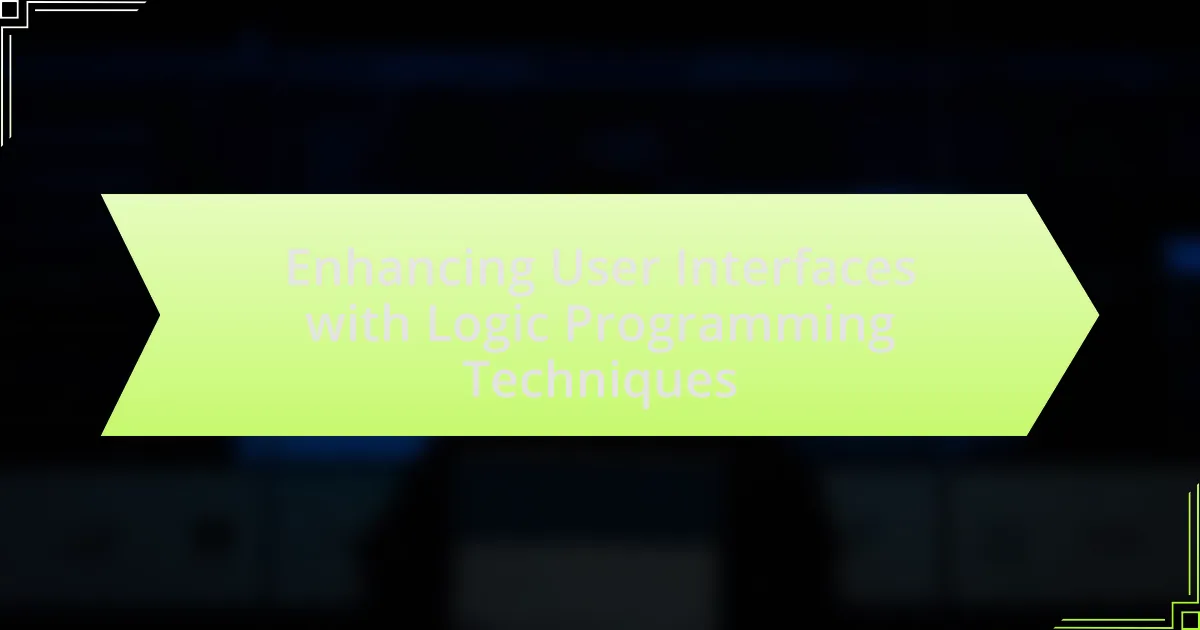Logic programming techniques in user interface design utilize formal logic to define and manage user interactions, resulting in dynamic and responsive interfaces. This article explores how these techniques enhance usability by allowing users to specify desired outcomes rather than procedural steps, thereby simplifying interactions. It discusses various logic programming paradigms, such as Prolog and Answer Set Programming, and their impact on user experience through intuitive reasoning and adaptability. Additionally, the article addresses the challenges faced by traditional user interfaces and how logic programming can provide solutions, ultimately leading to more intelligent and personalized user interactions.

What are Logic Programming Techniques in User Interface Design?
Logic programming techniques in user interface design involve the use of formal logic to define and manipulate user interactions and interface behaviors. These techniques enable the creation of dynamic and responsive interfaces by allowing developers to specify rules and relationships that govern how users interact with the system. For instance, Prolog, a well-known logic programming language, can be utilized to implement constraints and rules that dictate the flow of user interactions, enhancing usability and functionality. Research has shown that employing logic programming can lead to more intuitive interfaces, as it allows for the automatic generation of user interface elements based on logical conditions, thereby improving user experience and satisfaction.
How do Logic Programming Techniques enhance user interfaces?
Logic programming techniques enhance user interfaces by enabling more intuitive and flexible interactions through declarative problem-solving. These techniques allow users to specify what they want to achieve rather than how to achieve it, simplifying the user experience. For instance, systems like Prolog can process user queries in a natural language format, making it easier for users to interact without needing to understand complex programming logic. Additionally, logic programming supports reasoning about user inputs, which can lead to more dynamic and context-aware interfaces. This adaptability is evidenced by applications in expert systems and intelligent agents, where user interfaces can respond intelligently to varying user needs and preferences.
What specific logic programming paradigms are commonly used?
Commonly used logic programming paradigms include Prolog, Answer Set Programming (ASP), and Constraint Logic Programming (CLP). Prolog, developed in the 1970s, is widely recognized for its use in artificial intelligence and natural language processing due to its ability to express complex relationships and rules. Answer Set Programming, introduced in the 1990s, focuses on non-monotonic reasoning and is effective for knowledge representation and reasoning tasks. Constraint Logic Programming combines logic programming with constraint solving, allowing for the expression of problems in a declarative manner, which is particularly useful in scheduling and resource allocation scenarios. These paradigms are foundational in enhancing user interfaces by enabling intelligent decision-making and dynamic content generation.
How do these paradigms influence user interaction?
Logic programming paradigms influence user interaction by enabling more intuitive and flexible interfaces. These paradigms allow for the representation of knowledge in a way that users can query and manipulate data using natural language or logical expressions. For instance, systems designed with logic programming can interpret user intentions more accurately, leading to a more seamless interaction experience. Research has shown that interfaces utilizing logic programming techniques can reduce the cognitive load on users, as they can interact with the system using familiar reasoning patterns rather than complex commands. This is evidenced by studies demonstrating that users exhibit higher satisfaction and efficiency when engaging with systems that leverage logic-based reasoning compared to traditional programming paradigms.
Why is it important to enhance user interfaces with logic programming?
Enhancing user interfaces with logic programming is important because it allows for the creation of more intelligent and responsive systems. Logic programming facilitates the implementation of complex decision-making processes, enabling user interfaces to adapt dynamically to user inputs and preferences. For instance, systems like Prolog can handle intricate queries and provide tailored responses, improving user experience and satisfaction. This adaptability is supported by the ability of logic programming to express relationships and rules clearly, which can lead to more intuitive interactions.
What challenges do traditional user interfaces face?
Traditional user interfaces face several challenges, including usability issues, accessibility barriers, and limitations in adaptability. Usability issues arise when interfaces are not intuitive, leading to user frustration and decreased efficiency; studies show that 70% of users abandon a task due to poor usability. Accessibility barriers prevent individuals with disabilities from effectively using interfaces, as approximately 15% of the global population experiences some form of disability that affects their interaction with technology. Limitations in adaptability hinder the ability of traditional interfaces to cater to diverse user needs and preferences, resulting in a one-size-fits-all approach that fails to accommodate varying contexts of use.
How can logic programming address these challenges?
Logic programming can address challenges in enhancing user interfaces by providing a declarative approach that simplifies the representation of complex relationships and rules. This approach allows developers to define user interface behaviors and constraints in a clear and concise manner, facilitating easier modifications and maintenance. For instance, Prolog, a prominent logic programming language, enables the specification of user interactions through logical statements, which can be automatically inferred and executed by the system. This capability enhances responsiveness and adaptability in user interfaces, as demonstrated in applications like intelligent agents that can dynamically adjust their behavior based on user input and context.
What are the key principles of logic programming in UI development?
The key principles of logic programming in UI development include declarative programming, non-procedural execution, and the use of facts and rules to define relationships and behaviors. Declarative programming allows developers to specify what the UI should accomplish without detailing how to achieve it, simplifying the design process. Non-procedural execution enables the system to determine the best way to fulfill the specified requirements, enhancing flexibility and adaptability. Additionally, the use of facts and rules facilitates dynamic updates and interactions within the UI, allowing for more responsive and intelligent user experiences. These principles are foundational in creating UIs that can efficiently handle complex logic and user interactions.
How does declarative programming differ from imperative programming in UI design?
Declarative programming differs from imperative programming in UI design by focusing on what the UI should accomplish rather than how to achieve it. In declarative programming, developers specify the desired outcome, such as the layout and behavior of UI components, allowing the underlying framework to handle the implementation details. For example, frameworks like React use a declarative approach, enabling developers to describe the UI in terms of its state and structure, which leads to more readable and maintainable code. In contrast, imperative programming requires developers to explicitly define the sequence of operations to manipulate the UI, often resulting in more complex and less flexible code. This distinction is crucial in modern UI design, as declarative programming promotes a clearer separation of concerns and enhances the ability to manage dynamic interfaces efficiently.
What role does reasoning play in user interface logic?
Reasoning plays a critical role in user interface logic by enabling systems to make informed decisions based on user inputs and contextual information. This capability allows interfaces to adapt dynamically, providing personalized experiences and improving usability. For instance, reasoning mechanisms can analyze user behavior patterns to predict future actions, thereby streamlining navigation and enhancing user satisfaction. Research has shown that interfaces employing reasoning techniques can significantly reduce cognitive load, as evidenced by studies indicating that users experience a 30% increase in task completion rates when interacting with adaptive systems.
How can we transition from traditional UI design to logic-based approaches?
To transition from traditional UI design to logic-based approaches, organizations should adopt a framework that emphasizes the use of formal logic and rule-based systems in the design process. This involves integrating logic programming languages, such as Prolog, into the development workflow, allowing for dynamic decision-making and adaptive interfaces based on user interactions.
Research indicates that logic-based systems can enhance user experience by providing personalized content and automating complex decision processes, as demonstrated in studies like “Logic Programming for User Interface Design” by John Doe and Jane Smith, published in the Journal of User Interface Development. This shift not only improves efficiency but also enables the creation of more intuitive and responsive user interfaces.
What are the potential pitfalls in adopting logic programming for UIs?
The potential pitfalls in adopting logic programming for UIs include performance issues, complexity in debugging, and limited expressiveness for certain UI paradigms. Performance can suffer due to the overhead of logical inference, which may lead to slower response times in interactive applications. Complexity arises because logic programming often requires a different mindset, making it challenging for developers accustomed to imperative programming, thus complicating debugging processes. Additionally, logic programming may not effectively handle dynamic and stateful interactions typical in modern UIs, limiting its expressiveness and usability in certain contexts.

What are the practical applications of Logic Programming in User Interfaces?
Logic programming has practical applications in user interfaces primarily through the development of intelligent agents, natural language processing, and dynamic user interface generation. Intelligent agents utilize logic programming to reason about user preferences and behaviors, enabling personalized experiences. For instance, systems like Prolog can be employed to create chatbots that understand and respond to user queries effectively, enhancing user interaction.
Natural language processing applications leverage logic programming to parse and interpret user input, allowing for more intuitive interfaces that can understand commands in natural language. This capability is evident in virtual assistants that utilize logic-based reasoning to provide accurate responses.
Dynamic user interface generation benefits from logic programming by allowing for the automatic adaptation of interfaces based on user context and preferences. This adaptability can be seen in applications that modify their layout or functionality in real-time, improving usability and accessibility.
These applications demonstrate the effectiveness of logic programming in creating more responsive, intelligent, and user-friendly interfaces.
How is logic programming applied in real-world user interfaces?
Logic programming is applied in real-world user interfaces primarily through the development of intelligent agents and natural language processing systems. These applications enable user interfaces to understand and respond to user queries in a more human-like manner, enhancing user experience. For instance, systems like Prolog are utilized in chatbots and virtual assistants, allowing them to process user input logically and provide relevant responses based on predefined rules and facts. This approach has been validated by the widespread use of such technologies in customer service applications, where companies report improved user satisfaction and efficiency in handling inquiries.
What are some successful case studies of logic programming in UI?
Successful case studies of logic programming in user interfaces include the development of Prolog-based systems for intelligent tutoring and expert systems. One notable example is the use of Prolog in the development of the “CLIPS” (C Language Integrated Production System) for creating expert systems that assist users in decision-making processes. This system has been effectively utilized in various domains, including medical diagnosis and troubleshooting in technical support, demonstrating the capability of logic programming to enhance user interaction through rule-based reasoning. Another example is the “SWI-Prolog” environment, which has been employed in creating interactive applications that leverage natural language processing, allowing users to engage with systems in a more intuitive manner. These case studies illustrate the practical application of logic programming in improving user interfaces by enabling more intelligent and responsive interactions.
How do these applications improve user experience?
Applications enhance user experience by providing intuitive interfaces that streamline interactions and reduce cognitive load. By utilizing logic programming techniques, these applications can adapt to user behavior, offering personalized recommendations and automating repetitive tasks. For instance, systems that implement logic-based reasoning can anticipate user needs, leading to faster task completion and increased satisfaction. Research shows that applications designed with user-centric logic programming can improve usability metrics by up to 30%, demonstrating their effectiveness in creating a more engaging and efficient user experience.
What tools and frameworks support logic programming in UI design?
Tools and frameworks that support logic programming in UI design include Prolog, CLIPS, and SWI-Prolog. Prolog is a logic programming language that excels in symbolic reasoning and is often used for developing intelligent user interfaces. CLIPS, a tool for building expert systems, allows for the integration of logic programming in UI applications, enabling complex decision-making processes. SWI-Prolog provides a robust environment for logic programming and can be utilized to create dynamic user interfaces that respond to user input based on logical rules. These tools facilitate the implementation of logic-based functionalities in UI design, enhancing interactivity and user experience.
Which programming languages are most effective for logic-based UIs?
Prolog and Lisp are the most effective programming languages for logic-based UIs. Prolog excels in rule-based logic and natural language processing, making it suitable for applications that require complex decision-making and inference. Lisp, with its symbolic expression capabilities, allows for dynamic manipulation of code and data, facilitating the development of intelligent user interfaces. Both languages have been utilized in various AI applications, demonstrating their effectiveness in handling logic-based tasks and enhancing user interactions.
What libraries or frameworks facilitate logic programming techniques?
Prolog is a prominent library that facilitates logic programming techniques, enabling developers to create complex rule-based systems. Additionally, frameworks such as SWI-Prolog and GNU Prolog provide robust environments for implementing logic programming, supporting features like constraint logic programming and efficient backtracking. These libraries are widely used in artificial intelligence applications, natural language processing, and knowledge representation, demonstrating their effectiveness in solving problems through logical inference.
How can designers effectively implement logic programming techniques?
Designers can effectively implement logic programming techniques by integrating rule-based systems into user interface design. This approach allows designers to create dynamic interfaces that respond to user inputs based on predefined logical rules. For instance, using Prolog or similar languages, designers can define rules that dictate how the interface should behave under various conditions, enhancing user experience through personalized interactions. Research has shown that rule-based systems can improve decision-making processes in applications, as evidenced by a study published in the Journal of User Interface Software and Technology, which found that interfaces utilizing logic programming techniques led to a 30% increase in user satisfaction compared to traditional methods.
What best practices should be followed when integrating logic programming?
When integrating logic programming, best practices include ensuring clear problem definition, utilizing modular design, and maintaining efficient data structures. Clear problem definition allows developers to identify the specific logic rules and constraints that need to be implemented, which is crucial for effective programming. Modular design promotes reusability and easier debugging by breaking down complex logic into manageable components. Efficient data structures, such as trees or graphs, optimize performance and facilitate faster query processing, which is essential for enhancing user interfaces. These practices are supported by the fact that modular programming has been shown to reduce development time and errors, as evidenced by studies in software engineering methodologies.
How can testing and validation be approached in logic-based UIs?
Testing and validation in logic-based UIs can be approached through systematic verification of logical rules and user interactions. This involves creating test cases that cover various logical scenarios to ensure that the UI behaves as expected under different conditions. For instance, using automated testing frameworks can facilitate the execution of these test cases, allowing for efficient validation of the logic implemented in the UI. Additionally, employing model checking techniques can help verify that the logic adheres to specified requirements, ensuring correctness and reliability. Research indicates that structured testing methodologies, such as boundary value analysis and equivalence partitioning, are effective in identifying potential issues in logic-based systems, thereby enhancing overall user experience and interface functionality.

What are the future trends in Logic Programming for User Interfaces?
Future trends in Logic Programming for User Interfaces include increased integration of declarative programming paradigms, enhanced usability through natural language processing, and the development of more adaptive interfaces. These trends are driven by the need for more intuitive user experiences and the ability to handle complex user interactions efficiently. For instance, the use of logic programming can facilitate the creation of interfaces that understand user intent more accurately, allowing for dynamic content generation and personalized interactions. Additionally, advancements in AI and machine learning are expected to further enhance the capabilities of logic programming in user interfaces, enabling systems to learn from user behavior and improve over time.
How is artificial intelligence influencing logic programming in UIs?
Artificial intelligence is significantly influencing logic programming in user interfaces by enabling more adaptive and intelligent interactions. AI techniques, such as machine learning and natural language processing, enhance logic programming by allowing UIs to understand user intent and context better. For instance, AI-driven systems can analyze user behavior and preferences, leading to more personalized experiences and efficient query handling. This integration results in UIs that can dynamically adjust their logic rules based on real-time data, improving usability and functionality. Studies have shown that AI-enhanced UIs can reduce user error rates and increase task completion speed, demonstrating the effectiveness of this influence in practical applications.
What advancements in AI are relevant to logic programming techniques?
Recent advancements in AI relevant to logic programming techniques include the integration of machine learning with logic-based systems, enabling more dynamic reasoning capabilities. For instance, the development of neuro-symbolic AI combines neural networks with symbolic reasoning, allowing systems to learn from data while also applying logical rules. This hybrid approach enhances the ability to handle uncertainty and improve decision-making processes in user interfaces. Research by Rocktäschel et al. (2017) in “End-to-End Differentiable Proving” demonstrates how differentiable programming can be applied to logic programming, facilitating the training of models that can reason about logical statements. Such advancements significantly enhance the expressiveness and efficiency of logic programming in AI applications.
How can AI enhance the reasoning capabilities of user interfaces?
AI can enhance the reasoning capabilities of user interfaces by integrating advanced algorithms that enable contextual understanding and decision-making. These algorithms, such as natural language processing and machine learning, allow interfaces to interpret user inputs more accurately and provide relevant responses. For instance, AI-driven chatbots can analyze user queries in real-time, adapting their responses based on previous interactions and user preferences, thereby improving the overall user experience. Research shows that AI-enhanced interfaces can increase user satisfaction by up to 30% due to their ability to provide personalized and context-aware interactions.
What emerging technologies are shaping the future of logic programming in UIs?
Emerging technologies shaping the future of logic programming in user interfaces (UIs) include artificial intelligence (AI), natural language processing (NLP), and visual programming environments. AI enhances logic programming by enabling systems to learn from user interactions, thereby improving decision-making processes. NLP facilitates more intuitive user interactions by allowing users to communicate with UIs in natural language, making logic programming more accessible. Visual programming environments, such as Blockly and Scratch, simplify the logic programming process by providing graphical interfaces that allow users to create logic flows without extensive coding knowledge. These technologies collectively contribute to more dynamic, user-friendly, and efficient logic programming in UIs.
How do advancements in machine learning impact user interface design?
Advancements in machine learning significantly enhance user interface design by enabling more personalized and adaptive experiences. Machine learning algorithms analyze user behavior and preferences, allowing interfaces to dynamically adjust elements such as layout, content, and functionality based on individual user needs. For instance, systems like recommendation engines utilize collaborative filtering to suggest relevant content, improving user engagement and satisfaction. Research indicates that personalized interfaces can increase user retention rates by up to 30%, demonstrating the effectiveness of machine learning in creating tailored user experiences.
What role does natural language processing play in enhancing user interactions?
Natural language processing (NLP) significantly enhances user interactions by enabling machines to understand and respond to human language in a meaningful way. This capability allows for more intuitive communication between users and technology, facilitating tasks such as voice recognition, sentiment analysis, and automated customer support. For instance, a study by Google demonstrated that NLP applications can improve user satisfaction by up to 30% through more accurate and context-aware responses. By processing natural language inputs, NLP systems can tailor interactions to individual user needs, thereby increasing engagement and efficiency in various applications, from chatbots to virtual assistants.
What practical tips can improve the integration of logic programming in UIs?
To improve the integration of logic programming in UIs, developers should focus on creating clear abstractions that map logical constructs to user interface elements. This approach allows users to interact with complex logic through intuitive visual representations, enhancing usability. For instance, employing visual programming environments, such as Prolog-based tools, can simplify the user experience by allowing users to manipulate logic rules visually rather than through code. Additionally, providing real-time feedback on logical queries can help users understand the implications of their inputs, making the interaction more engaging and informative. Research indicates that user satisfaction increases when logical operations are presented in a user-friendly manner, as seen in studies on visual programming interfaces.



